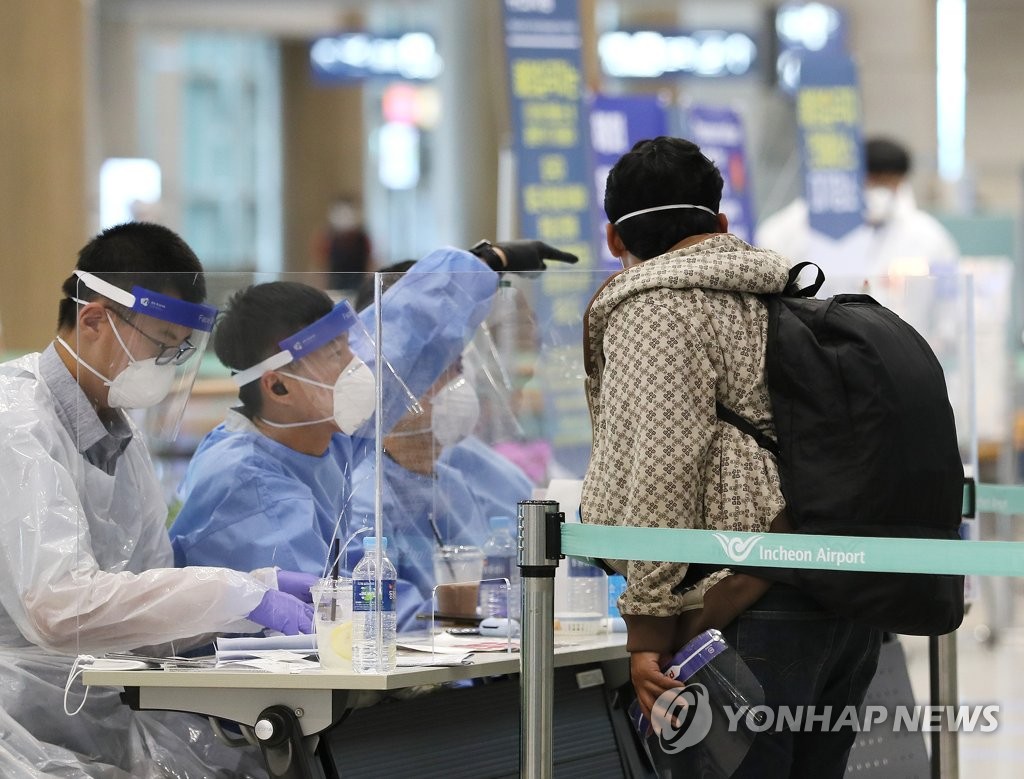- California Assembly OKs highest minimum wage in nation
- S. Korea unveils first graphic cigarette warnings
- US joins with South Korea, Japan in bid to deter North Korea
- LPGA golfer Chun In-gee finally back in action
- S. Korea won’t be top seed in final World Cup qualification round
- US men’s soccer misses 2nd straight Olympics
- US back on track in qualifying with 4-0 win over Guatemala
- High-intensity workout injuries spawn cottage industry
- CDC expands range of Zika mosquitoes into parts of Northeast
- Who knew? ‘The Walking Dead’ is helping families connect
New virus cases at over 3-week low, imported cases still rising
South Korea’s new daily virus cases fell below 30 for the first time in more than three weeks on Monday in a potential sign of a slowdown in virus infections, but imported cases continued to rise by double-digit figures.
The country identified 26 new cases, raising the total caseload to 13,771, according to the Korea Centers for Disease Control and Prevention (KCDC). Of the newly added cases, just four were local infections.
It was the lowest daily increase since 17 cases reported on June 22.
The number of locally transmitted cases also reached a single-digit figure for the first time in two months after nine cases on May 19, the KCDC data showed.
It marked a drastic turnaround from the previous day, when the country reported more locally transmitted cases than imported cases for the first time in eight days.
The country has seen double-digit numbers of imported cases for 25 consecutive days as of Monday, adding 22 of such cases.


Health officials give instructions to arrivals at Incheon International Airport in Incheon, west of Seoul, on July 20, 2020. (Yonhap)
South Korea has recorded a sharp increase in the number of imported cases, mostly attributable to workers returning from Iraq and a series of cluster infections on Russian-flagged vessels docked in the country’s southeastern port city of Busan.
The country has been struggling to curb such infections detected at border check-points, requesting foreign arrivals from six high-risk nations to submit proof of negative virus test results.
The KCDC, however, said there were three arrivals from the countries who tested positive for the virus here despite handing in the proof.
The accumulated number of imported cases reached 2,067, with Asian countries, excluding China, taking up 39 percent of the total, the KCDC data showed. Arrivals from the Americas accounted for 34 percent. Those from China were responsible for 1 percent.
Of the locally transmitted cases reported on Monday, two were from Seoul.
An office building in the capital city’s southwestern ward of Gwanak reported one more case Monday, raising the total related caseload to 33.
A nursing home in western Seoul also reported nine new COVID-19 cases Monday, although this was not yet included in the daily tally. Authorities are currently tracking their infection routes.
Gwangju, located some 330 kilometers south of Seoul, added one more case Monday.
Health authorities said over the past two weeks, virus cases with unknown infection routes decreased to 7 percent of the total from around 10 percent.
“As the global COVID-19 pandemic is showing no signs of a slowdown, we are focusing more on imported cases,” said Vice Health Minister Kim Ganglip during a regular briefing.
“However, as most of the imported cases are being detected at checkpoints, there is little chance for such cases to lead to local infections,” Kim added. “Nevertheless, the COVID-19 pandemic will last until effective treatments or vaccines become available, and we are now preparing for a long battle with the virus.
South Korea, which did not impose a full lockdown since detecting its first COVID-19 case in January, lifted most of its social distancing rules in early May when it reported single-digit daily cases.
The country later decided to again tighten social distancing rules in Seoul and its surrounding areas in June due to growing infections from nightlife establishments, churches, and logistics centers.
With the number of daily local transmissions recently hovering around 20 or below, South Korea resumed operations of some museums and libraries in the greater Seoul area starting Monday.
The public facilities have adopted a quick response (QR) code-based registration system that can help health authorities track potential virus cases, according to the authorities.
South Korea has already applied the system at around 133,000 facilities nationwide that are deemed vulnerable to virus spread, including bars, clubs and religious facilities.
Health authorities, however, are still vigilant over the spread of the virus in vacation spots over the summer, pointing out that the season will serve as a critical juncture for the nation’s anti-virus fight.
“We urge people to spend their vacation at home,” KCDC Director Jeong Eun-kyeong said. “At vacation spots, people should travel in small groups and follow social distancing rules.”
The country’s death toll came to 296, with one more virus-caused death reported, according to the KCDC. The fatality rate reached 2.15 percent.
As of Monday, 12,572 of the infected have been released after a full recovery, up 16 from a day before.
The country has carried out 1,470,193 COVID-19 tests so far.
Of virus patients reported in South Korea, patients aged 59 and below accounted for 70 percent. No deaths were reported from those aged under 30, the data also showed.
But among 488 COVID-19 patients traced to door-to-door sales businesses in the country, a whopping 73 percent of them were aged 50 and above.
Some 9 percent of the patients identified here were in critical condition, requiring oxygen therapy.
Meanwhile, a man was detained earlier in the day for allegedly having lied to health authorities about his job and itinerary before testing positive for the virus, which eventually led to a community spread in Incheon, about 40 km west of Seoul, in May.











